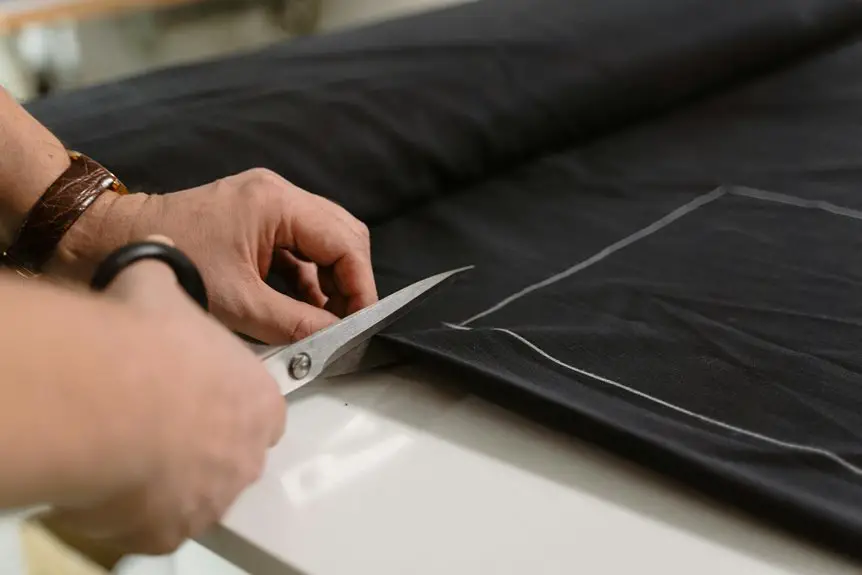Lyocell is a soft, durable fabric made from eucalyptus wood pulp, created with your environmental impact in mind. Its production uses a closed-loop process that recycles over 99% of solvents, minimizing waste and reducing water and energy use. You’ll appreciate lyocell’s smooth touch, moisture-wicking ability, and biodegradability, making it a great alternative to cotton or synthetic fabrics. If you want to know how it stacks up against other eco-friendly textiles and its everyday uses, keep exploring.
Table of Contents
Key Takeaways
- Lyocell is a sustainable fabric made from eucalyptus wood pulp, combining cotton’s softness with synthetic fiber strength.
- It is produced using a closed-loop process recycling over 99% of non-toxic solvents, minimizing environmental impact.
- Lyocell fibers are biodegradable, strong when dry or wet, and have a smooth surface for enhanced comfort and durability.
- Compared to other sustainable fabrics, lyocell is softer, more breathable, and uses less water and harmful chemicals in production.
- Commonly used in clothing and home textiles, lyocell offers moisture-wicking, hypoallergenic properties, and wrinkle resistance.
Understanding the Origins of Lyocell
Although you mightn’t realize it, lyocell’s origins lie in a blend of innovation and sustainability.
You’ll find that lyocell was developed in the 1980s as a response to environmental concerns linked to traditional fabrics. Scientists aimed to create a fabric that combined the natural feel of cotton with the strength and durability of synthetic fibers. They turned to wood pulp, primarily from eucalyptus trees, as the raw material.
Developed in the 1980s, lyocell blends cotton’s softness with synthetic strength using sustainable eucalyptus wood pulp.
This choice wasn’t random; it offered a renewable source that could be responsibly managed. As you explore lyocell’s background, you’ll see how this fiber represents a shift toward more conscious material choices.
Understanding these roots helps you appreciate why lyocell appeals to those seeking both comfort and environmental responsibility in textiles.
The Eco-Friendly Production Process of Lyocell
Building on lyocell’s sustainable origins, its production process stands out for being environmentally responsible at every step. You’ll appreciate how the closed-loop system recycles nearly all solvents, minimizing waste and pollution. Unlike traditional fibers, lyocell’s manufacturing uses non-toxic solvents that are reclaimed at a rate of over 99%. This means less harm to ecosystems and cleaner air. Plus, the process demands less water and energy, reducing its carbon footprint. When you choose lyocell, you support a cycle that respects the planet and its resources.
| Aspect | Impact on Environment |
|---|---|
| Closed-loop system | Nearly zero solvent waste |
| Non-toxic solvents | Safer for workers & wildlife |
| High solvent recovery | 99%+ recycled |
| Reduced water use | Conserves freshwater |
| Lower energy demand | Cuts greenhouse gases |
Key Physical and Chemical Properties of Lyocell
When you examine lyocell’s key physical and chemical properties, you’ll find a fiber that combines strength, softness, and moisture management in a unique way.
Lyocell fibers are made from cellulose, giving them excellent biodegradability and chemical stability. You’ll also notice they’ve a smooth surface, which reduces friction and enhances comfort.
Derived from cellulose, lyocell fibers offer biodegradability and a smooth surface that boosts comfort and reduces friction
Here are three standout properties:
- Strength and Durability: Lyocell is stronger than cotton, both when dry and wet, so your garments last longer.
- Moisture Absorption: It absorbs moisture efficiently, keeping you dry and comfortable.
- Softness and Smoothness: Its fine fibers give lyocell a silky feel that’s gentle on your skin.
These qualities make lyocell a versatile and practical fabric choice.
Comparing Lyocell With Other Sustainable Fabrics
Since sustainable fabrics each offer unique benefits, comparing lyocell with others helps you choose the best material for your needs.
Lyocell stands out for its softness and breathability, often feeling smoother than organic cotton or hemp. Unlike bamboo viscose, lyocell’s closed-loop production reduces harmful chemicals, making it more eco-friendly.
While linen is durable and moisture-wicking, it wrinkles easily, whereas lyocell maintains a polished look longer. Compared to recycled polyester, lyocell is biodegradable and less reliant on fossil fuels, appealing if you want a natural fiber.
However, lyocell can be pricier than some alternatives. By understanding these distinctions, you can pick a sustainable fabric that balances comfort, environmental impact, and cost effectively for your specific needs.
Applications and Benefits of Lyocell in Everyday Textiles
Although lyocell might be less familiar than cotton or polyester, you’ll find it increasingly used in everyday textiles due to its unique blend of comfort and sustainability.
When you choose lyocell products, you enjoy softness, breathability, and moisture-wicking properties that keep you comfortable all day. It’s also hypoallergenic, making it ideal for sensitive skin.
Here are three common applications and benefits you’ll appreciate:
- Clothing: Lightweight and drapes well, perfect for shirts, dresses, and activewear.
- Home Textiles: Durable and resistant to wrinkles, great for bed linens and towels.
- Eco-friendly Choice: Produced with fewer chemicals and less water, reducing environmental impact.
Frequently Asked Questions
Can Lyocell Fabric Cause Allergies or Skin Irritation?
You typically won’t experience allergies or skin irritation from lyocell fabric since it’s hypoallergenic and breathable. However, if you have sensitive skin, always wash new garments first to avoid any potential reaction from residual chemicals.
How Does Lyocell Fabric Care and Washing Differ From Cotton?
You’ll find lyocell uses 30% less water than cotton when washed. Since lyocell’s delicate, you’ll want cold water and gentle cycles, unlike cotton’s tougher fibers that handle warm washes and more agitation.
Is Lyocell Biodegradable and How Long Does It Take to Decompose?
You’ll find lyocell biodegradable since it’s made from natural cellulose fibers. It typically decomposes within a few weeks to a few months in composting conditions, making it an eco-friendly fabric choice compared to synthetics.
What Are the Common Blends of Lyocell With Other Fibers?
You might think lyocell only works solo, but it’s often blended with cotton, polyester, or wool. These blends boost durability, comfort, and moisture-wicking, making your clothes feel better and last longer without sacrificing eco-friendliness.
Does Lyocell Fabric Shrink or Wrinkle Easily After Washing?
You won’t find lyocell fabric shrinking much after washing since it’s quite stable. It resists wrinkles better than cotton, but you might still see some creases. Always wash gently to keep it smooth and fresh.
- Is Cotton Percale a Good Choice for Bedding? Pros and Cons - July 14, 2025
- Why Are Percale Sheets So Cool? The Weave That Maximizes Airflow - July 14, 2025
- What Is Percale Weave Cotton and How Does It Feel? - July 14, 2025







